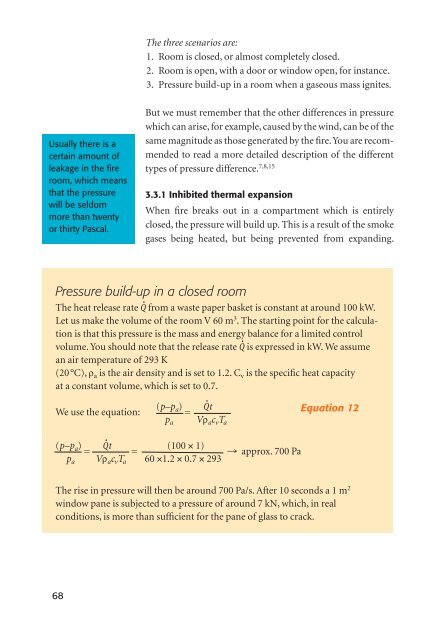You also want an ePaper? Increase the reach of your titles
YUMPU automatically turns print PDFs into web optimized ePapers that Google loves.
Usually there is a<br />
certain amount of<br />
leakage in the fi re<br />
room, which means<br />
that the pressure<br />
will be seldom<br />
more than twenty<br />
or thirty Pascal.<br />
68<br />
The three scenarios are:<br />
1. Room is closed, or almost completely closed.<br />
2. Room is open, with a door or window open, for instance.<br />
3. Pressure build-up in a room when a gaseous mass ignites.<br />
But we must remember that the other differences in pressure<br />
which can arise, for example, caused by the wind, can be of the<br />
same magnitude as those generated by the fi re. You are recommended<br />
to read a more detailed description of the different<br />
types of pressure difference. 7,8,15<br />
3.3.1 Inhibited thermal expansion<br />
When fi re breaks out in a compartment which is entirely<br />
closed, the pressure will build up. This is a result of the smoke<br />
gases being heated, but being prevented from expanding.<br />
Pressure build-up in a closed room<br />
The heat release rate Q from a waste paper basket is constant at around 100 kW.<br />
Let us make the volume of the room V 60 m 3 . The starting point for the calculation<br />
is that this pressure is the mass and energy balance for a limited control<br />
volume. You should note that the release rate Q is expressed in kW. We assume<br />
an air temperature of 293 K<br />
(20 °C), 3 a is the air density and is set to 1.2. C v is the specifi c heat capacity<br />
at a constant volume, which is set to 0.7.<br />
We use the equation:<br />
(p–p a) = Qt<br />
p a V3 ac vT a<br />
(p–p a) = Qt = (100 × 1) P approx. 700 Pa<br />
p a V3 ac vT a 60 ×1.2 × 0.7 × 293<br />
Equation 12<br />
The rise in pressure will then be around 700 Pa/s. After 10 seconds a 1 m 2<br />
window pane is subjected to a pressure of around 7 kN, which, in real<br />
conditions, is more than suffi cient for the pane of glass to crack.

















